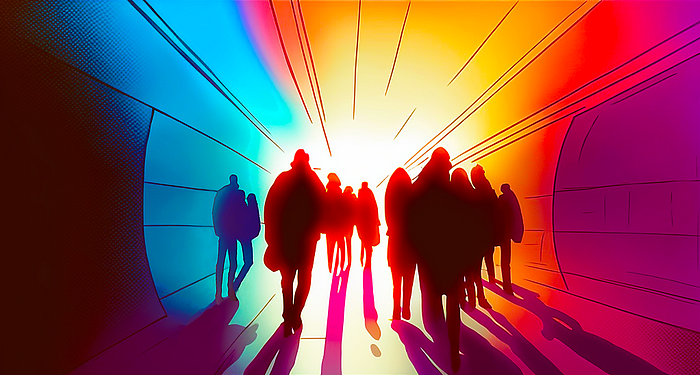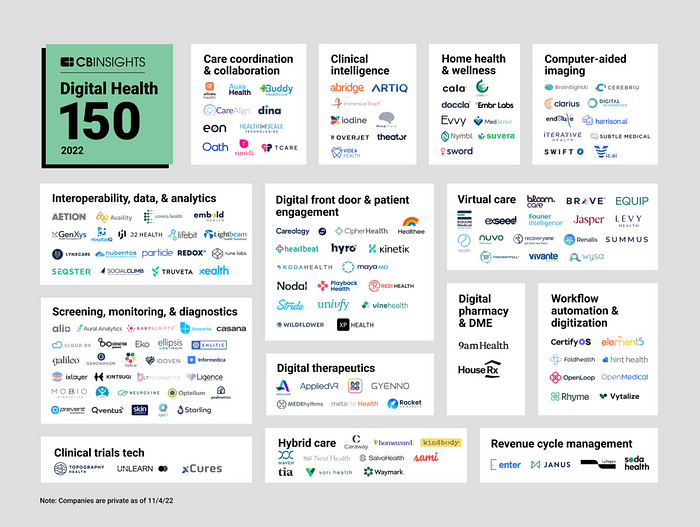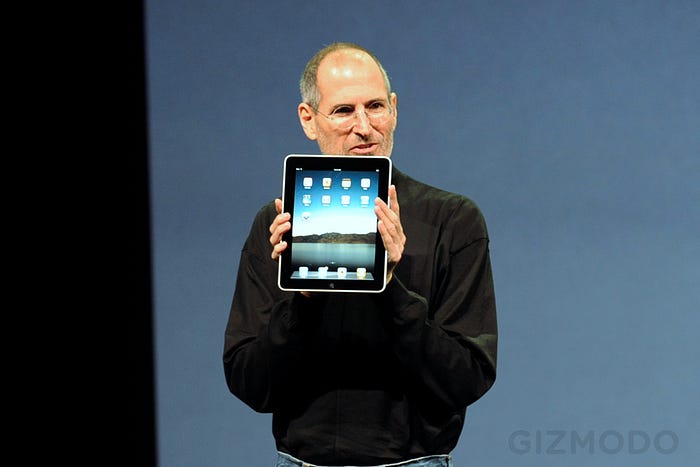

The future of UX: 2023 and beyond
source link: https://uxdesign.cc/the-future-of-ux-2023-and-beyond-10e916e208c6
Go to the source link to view the article. You can view the picture content, updated content and better typesetting reading experience. If the link is broken, please click the button below to view the snapshot at that time.
The future of UX: 2023 and beyond
Despite anxiety about the economy and AI, the future of UX is brighter than ever. Here’s why.

Illustration by author using Midjourney AI + Photoshop
Working in the UX industry means living in a constant state of flux. Every day seems to bring new technologies, skills, business challenges, and user expectations to absorb. That’s why every December, I eagerly await the release of UX Collective’s State of UX report, in which authors Fabricio Teixeira and Caio Braga (plus collaborators) synthesize thousands of articles in order to put the past year into perspective and highlight emerging themes for the road ahead.
The underlying theme for this year’s report was anxiety. Massive layoffs at tech stalwarts like Facebook, Google, and Amazon, along with headlines about an economic slowdown, have some designers thinking about how to recession-proof their jobs. With headcounts shrinking, design teams are expected to do more with less, and former managers are returning to hands-on work. As experienced UX designers who have been displaced by layoffs compete for job openings, new entrants to the field worry that their chances have moved from difficult to impossible. And with mobile apps and websites looking more and more the same, the potential commoditization of design leads to uncertainty around an important question:
The Future of UX: 4 Transformative Opportunities
The good news is that working in a constantly changing field makes us adaptable, sharp, and resourceful. We’ll need those abilities to take advantage of 4 emerging and transformative opportunities to move UX away from commoditized tasks and into positions of leadership for the future:
Opportunity #1: Leaning into the AI Revolution
With the much-publicized release of the simple-yet-powerful ChatGPT, mainstream AI has passed a tipping point. While designers are wondering about how to navigate the AI revolution, businesses and investors are evaluating AI’s potential to disrupt entire industries.
AI could “de-FAANG” the tech industry.
When I first started my career, the tech behemoths that we now refer to as FAANG: Facebook (now Meta), Apple, Amazon, Netflix, and Google, didn’t exist in the form that we think of today. Facebook hadn’t been created yet, Netflix was simply a DVD rent-by-mail company, and you wouldn’t Google anything, you would “Yahoo it.” (Ok, no one actually said “Yahoo it.”) The FAANG companies took advantage of opportunities made possible by new technologies and societal shifts, such as ubiquitous broadband (Netflix streaming), falling storage costs (Google’s web index), miniaturization of hardware (Apple’s iPod / iPhone), and online behaviors (Amazon / Facebook).
We are currently heading into another era, an AI revolution, with the potential to cripple or eliminate today’s tech giants. We’ve already started to see a glimpse of the coming flood of AI startups and new AI product offerings from existing players. The release of ChatGPT caused Google’s management to declare a “code red,” and has “upended the work of numerous groups inside the company” in response to the threat. A flood of inauthentic, AI-generated content (and users) could accelerate the exodus from mainstream social media sites like Facebook and Instagram to private networks and decentralized alternatives (a.k.a the Fediverse). And with Microsoft set to take a 49% stake in OpenAI (the creator of ChatGPT), Apple could find itself disrupted by an AI-powered operating system like the one we’ve seen in the movie “Her.”
Trailer for Her (2013) — Warner Brothers.
UX must adapt to lead the future of AI experiences.
In the movie Her, the protagonist (played by Joaquin Phoenix) purchases an AI-powered operating system for his mobile device. While using it, his verbal interactions with the AI primarily drive the user experience, not the physical UI of the device. In a world like this, what role does a UX designer play? As we slide ever closer to this reality, there are 4 major shifts to anticipate:
- Design will become more conversational and conceptual.
As AIs become increasingly capable of responding to human language, the design of user experiences will shift from tangible UI to conversational interfaces, making conversational design a critical skill for UX designers. The ability to map out experiences will also be crucial in this new world, as designers will need to anticipate and visualize the conversational paths that users may take with AIs. Additionally, communicating how AIs work in easy-to-understand formats like visual algorithms and decision trees will be important for building transparency and trust with the public. - Psychology will turn into a primary skill set.
Researching and understanding user mental models, cultural context, and emotions will become increasingly important. Additionally, behavioral design, which takes into account the motivations and factors that influence behavior in order to affect positive change, will play a significant role in creating AI experiences that support healthy interactions and mental well-being. - New ethical questions will arise more and more often.
In the movie Her, the AI (voiced by Scarlet Johansen) engages in a romantic relationship with the protagonist. Was this ethical? Before you respond, consider the fact that the AI was a product that was purchased from a for-profit company that had access to all of the protagonist’s personal data and could observe him 24 hours a day. Although this is a fictional scenario, determining the appropriate level of intimacy in the relationship between an AI and its users is just one example of the many ethical questions in AI that are already emerging. It is important for all people to adopt ethical design practices, not just designers. - Representation, equity, and accountability will be more important than ever.
Ensuring that the design and training of AI leverage representative data and leads to equitable outcomes will be essential to preventing the kinds of cultural and racial biases that we’ve already seen from AI. Some of these include Microsoft’s public experiment with an AI named Tay, who was designed to mimic a teenager and learn by interacting with users on Twitter, only to discover that it quickly learned to become a foul-mouthed, xenophobic racist. The use of AI in hiring and job performance evaluations has been found to perpetuate bias and reinforce existing inequalities. In fact, people have already tricked ChatGPT into revealing some of its underlying racist assumptions.
Near-Term impact on developers will lead to impact on UX.
So far, one of the most impressive feats of ChatGPT has been its ability to assist programmers and even produce (almost) production-quality code. While this increased speed and efficiency could provide an excuse for developer staff reductions, the more likely scenario is for businesses to take advantage of new AI-coding capabilities to pull ahead of their slower moving competitors. This could be a boon to designers, as the increased bandwidth would lead to greater resources available for enhancing user experiences.
AI can free our time to focus on what matters.
As the technology factors that promote great user experiences (speed, accessibility, flexibility, etc.) become table-stakes, the remaining differentiation will come from genuinely understanding users and tailoring experiences to their needs. In a competitive environment like this, the practices of “UX Theater” (i.e. the illusion of following user-centered methods but without involving users) and UX as “User Exploitation” would no longer be tenable. With AI transforming UX and accelerating user research, maybe we can finally get back to what matters most: The user.
Opportunity #2: Designing a Better “Human Experience”
The headlines talking about layoffs and recessions are certainly concerning. But it’s important that they don’t overshadow the larger threats that our world is facing, including unsustainable business practices that worsen the climate crisis, and socio-economic inequalities that reinforce cycles of poverty and systemic racism.
It’s time to take a more holistic look at the designs that we produce, and the companies that produce them. While you might be creating a great “user experience” for your product or service, if you factor in your company’s material waste, carbon footprint, labor exploitation, manipulative practices, and psychologically harmful products, you might find that you’ve ended up with a pretty terrible “human experience.”
On the other hand, there are a number of organizations whose mission is to promote ethical practices in design, and call out companies whose products are designed to maximize profit at the expense of individual wellbeing. For example, The Center for Humane Technology is a non-profit organization that works to reshape technology to better serve the needs of humanity. Many people are familiar with their work communicating the negative effects of social media in The Social Dilemma, and they provide a number of additional resources like free online courses in creating responsible technology, and easy-to-share facts and figures via their Ledger of Harms.
There are many opportunities for you to use design for a positive impact as well:
Design for nonprofits and social-good companies.
Designing for these types of organizations allows you to apply your skills to creating tools and experiences that promote sustainability, equality, and social justice. These can include increasing access to financial or educational resources, improving health equity, shifting to sustainable practices, assisting with international aid and human rights, and more.
There are a growing number of job boards and online communities created for those who want to work or volunteer with social good organizations, some of which are listed below:
- Social Change by Design (Organization Database)
- Design Gigs for Good (Job Board)
- All Hands (Job Board)
- Tech Jobs for Good (Job Board)
- Idealist (Job Board and Volunteering for Nonprofits)
- UX Rescue (Volunteer Opportunities)
- Catchafire (Volunteer Opportunities)
- Designers Group for Good (Slack Group)
- Cultivate Community (Slack Group)
- More resources available here
Design for government and civic technology.
Designing in this space lets you play an important role in helping governments and civic organizations understand and meet the needs of their diverse constituents, as well as enabling communities to have a voice in the democratic process. This can include creating tools, websites, and apps to improve digital service delivery, increase civic engagement, visualize complex data to promote informed decision-making, and much more. Recognizing the importance of design in serving the public, U.S. President Biden issued an executive order on Transforming Federal Customer Experience and Service Delivery to Rebuild Trust in Government, stating:
[The] Federal Government’s [customer experience] and service delivery should be driven fundamentally by the voice of the customer through human-centered design…
Answering the call to serve could mean working directly for your local or state governments, or at the Federal level. There are also quite a few for-profit companies who specialize in developing equitable, human-centered digital services for the government, such as the member companies of the Digital Services Coalition.
Beyond UX, Service Design is a rapidly growing capability that is needed throughout the public sector. Service designers can help government agencies to better understand the lives of their constituents, and work collaboratively with them to map the ideal customer journey and design service blueprints to guide organizations in structuring themselves around that journey. Taking this a step further, the Federal Government has created a “life experience” organizing framework where multiple agencies coordinate the design of their services to help citizens address significant life events, such as recovering from a natural disaster or navigating reentry into civilian life for recent veterans.
Design for Public Policyis an emerging field that pairs human-centered design practitioners with public policy experts to create more effective and equitable policies and programs, as well as visual communications of those policies. Traditional design activities such as user research, prototype testing, and co-creation with community stakeholders help to identify specific needs, and tailor the delivery of services to address them. While organizations who merge design with policy are more common in Europe and elsewhere, the US has some as well, including Public Policy Lab and New America.
With the move to remote work (due to the pandemic) many positions no longer require you to be located onsite in Washington D.C. or in your state capital. Here are some Federal Government resources to get you started:
- U.S. Digital Service: Uses design and technology to deliver better services to the American people.
- General Services Administration (GSA) Centers of Excellence: An accelerator of IT modernization across the government to improve the public experience and increase operational efficiency.
- 18F: A digital consulting office that partners with agencies to help them build or buy digital services.
- Presidential Innovation Fellowship (PIF): A program that pairs top technologists with civil-servants to spend 12 months tackling some of our nation’s biggest challenges.
- United States Digital Corps: Fellowship program for early-career technologists to launch impactful careers in public service and create a more effective, equitable government.
There are also lots of ways to work or volunteer with projects and organizations in “Civic Tech,” a.k.a. technology for the public good that empowers citizens and improves democracy and civic infrastructure. These include international organizations like the members of the Code for All Global Network, as well as ones based in the U.S. such as Code for America and U.S. Digital Response.
Opportunity #3: Saving Lives through Design in Healthcare
The COVID-19 pandemic spawned an explosion of innovations in the health sector, providing designers with numerous places to contribute to saving and improving lives. For example, design can improve patient outcomes and quality of care by decreasing time spent navigating inefficient software, layers of intermediaries, and regulatory hurdles.

CB Insights most promising digital health companies of 2022
We’ve already seen a major paradigm shift in the move to tele-health. And new wearable and connected technologies are transforming at-home patient care, and granting elderly people the freedom to live wherever they choose.
Finally, the pandemic exposed and exacerbated the mental health crisis faced by millions of people. A new frontier of startups and nonprofits have emerged to face this challenge, and UX has the potential to connect those in need to mental health providers, suicide interventions, and supportive communities, as well as provide apps and services to promote physical and mental well being.
Opportunity #4: Creating New Realities
Meta’s current failure to drive widespread adoption of its virtual reality (VR) MetaVerse comes after a long track record of disappointments and deflated expectations regarding VR. Augmented Reality (AR) has followed a similar trajectory of inflated industry hype followed by decline into its current, gimmicky status of allowing people to chase Pokémon, place furniture in their rooms, or locate constellations in the sky. Still, don’t write these technologies off just yet…
AR/VR is about to have its “iPad Moment.”
When Steve Jobs revealed the first iPad in January of 2010, many critics were quick to criticize Apple’s decision to release a tablet. At that point in history, tablet computers (as they were called then) had been tried and failed, most notably by Microsoft. Apple went on to prove all of them wrong by completely redefining the perception and experience of tablets, and ultimately selling hundreds of billions of dollars of them in the process.

Steve Jobs introduces the iPad, January 2010. Photo by Matt buchanan — via Flickr, CC BY 2.0,
Earlier in my career, I worked with Samsung on marketing and developing app concepts for their GearVR (the first consumer VR headset powered by a smartphone.) While the experience of GearVR and other smartphone-based VR solutions were entertaining, they were also infuriating. Persistent physical discomfort, device overheating, and software disruptions meant they could never be used for more than a few minutes at a time. In addition, the awkwardness of strapping a block onto your face, combined with the isolation from people around you meant you needed to either use them while completely alone, or be comfortable with people gawking at you in public.
Get ready for a new reality.
That’s why I was thrilled by the leaked news of Apple’s “XR headset” (name unconfirmed) which indicates that they’ve addressed the major design flaws that have plagued AR and VR devices until now. According to the leak, the headset will have an outward-facing display that shows the facial expressions of the headset wearer to reduce the feeling of isolation while it is being worn. The headset will also be as comfortable as possible, with the battery moved down to the belt to make it lighter, reduce heat, and allow for easy swapping.
A truly mainstream AR/VR (a.k.a. “mixed reality) headset opens up infinite possibilities for imaginative and experimental uses in storytelling, marketing, and gaming, as well as for augmenting existing activities like virtual calls and meetings, training, sports, navigation, 3D design, and more. These possibilities also demand that UX designers expand their skills into the world of mixed reality to ensure that these new experiences succeed with users.
The future of UX is in your hands.
This article isn’t intended to predict the future. I believe that people have the power to shape the future through their choices, so I’ve presented 4 emerging and transformative “opportunities” to act on if you choose. The field of UX is both expanding in breadth, and deepening into specializations. It is impossible to be an expert in everything, so you will need to make some choices about where to focus your efforts.
Great UX can mean the difference between success and failure for organizations as they try to seize these emerging opportunities. And the adaptability and resourcefulness of UX designers can help their organizations navigate the ever-accelerating pace of change. This means that your decision about where you work not only affects your own path, it affects the world.
Ultimately, it’s the sum total of all of our choices that will shape the future of UX. So choose wisely.
Recommend
About Joyk
Aggregate valuable and interesting links.
Joyk means Joy of geeK